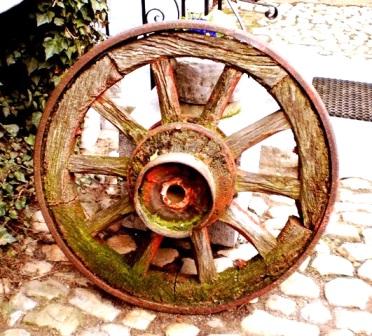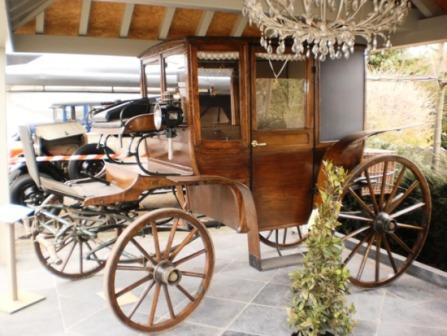The first tools to move heavy loads were levers and rollers. Roles are about equal thick round stems that are placed under the load. Such matters are to be rolled forward. The roles that are released at the back have to be put back under at the front.
This works well on a fairly flat and hard surface. Otherwise should be laid in the length first logs as rails.
The rollers have a clear function: reduce friction between two moving parts. Small bumps you climb easier with thick than with small roles (or wheels).
 The next development was a full wooden wheel. The original intention was that they were interconnected by a fixed shaft which was hanging in brackets under the cart. With this only slow, wide turns can be taken. And there is friction, hence resistance, of the entire shaft. These problems are solved when the wheel disk is created a hub which turns around the axis. Only the hub should be lubricated (instead of the complete shaft) in order to reduce friction.
The next development was a full wooden wheel. The original intention was that they were interconnected by a fixed shaft which was hanging in brackets under the cart. With this only slow, wide turns can be taken. And there is friction, hence resistance, of the entire shaft. These problems are solved when the wheel disk is created a hub which turns around the axis. Only the hub should be lubricated (instead of the complete shaft) in order to reduce friction.
By making holes in the wheel disc it was lighter and arose cross- or H wheels.
Around 1,000 BC there was the first wheel with spokes. Sometimes the tread was reinforced by crooked stamped brass tacks.
The wheels of old carriages consisted of a center piece of elm wood, this was called the hub. The spokes were made of oak. The rim consisted of ash. To make the wheel sturdier one hit an iron band around it.
To put a wheel on an axle so it can turn around without to run off the shaft you can hit a pin trough the shaft, or compress a ring around the shaft. To make rotate the shaft along you make a recess in the inside of the hub and the outside of the shaft, and save in a small wedge (or 2, 3) (e.g. for a potters wheel).
 The first spoke wheels had a limited life because the hubs pumped while driving in the bearings. To fix them a “pre-tension“ should come on the wheel to prevent that movement of hubs and spokes. For this, an iron hoop was heated so he dilated and just fit around the wheel. Then it was cooled down on the wheel. The shrink compressed all wheel parts.
The first spoke wheels had a limited life because the hubs pumped while driving in the bearings. To fix them a “pre-tension“ should come on the wheel to prevent that movement of hubs and spokes. For this, an iron hoop was heated so he dilated and just fit around the wheel. Then it was cooled down on the wheel. The shrink compressed all wheel parts.
Like the iron band compresses and holds the staves of a barrel.
The tread reinforcement is a nice additional bonus factor.
In England, a Celtic cartwheel was found. It consisted of a single piece round bended ash, fastened with willow spokes on an elm hub. Old Irish folktales are also talking about metal coating (bronze, copper and even gold).
I once read that there should have been tires, a strip of leather, which was being fixed with a lot of screws and a bloated horse intestine inside. I have no confirmation found about this, and find it rather implausible. I do not think you can make an effective tire with a horse intestine under pressure.
Read more often and believable is the story that in the absence of rubber in the world war (s) defective tires were securely filled with hay.
Where there's wheel, there's way. (Gerd de Ley)
Who invented the first wheel was an idiot. The guy who invented the other three, that was a genius! (Sid Cesaer)
If it has tires or testicles, you will have problems with it. (Linda Furny)
